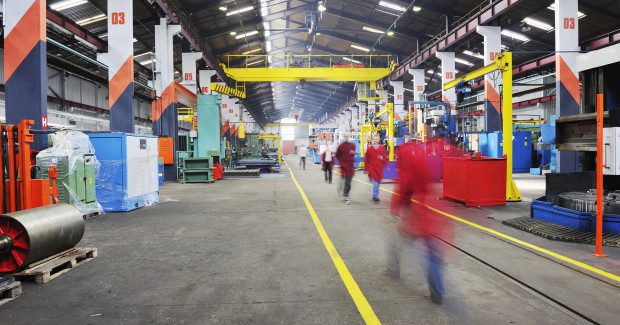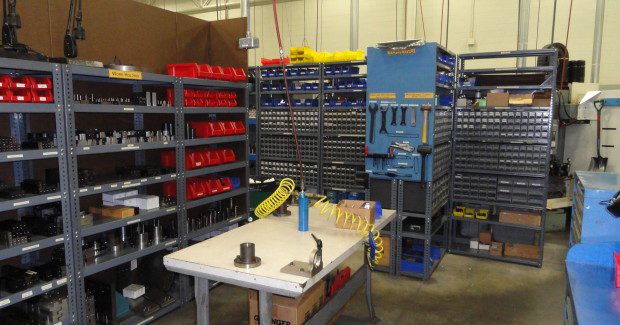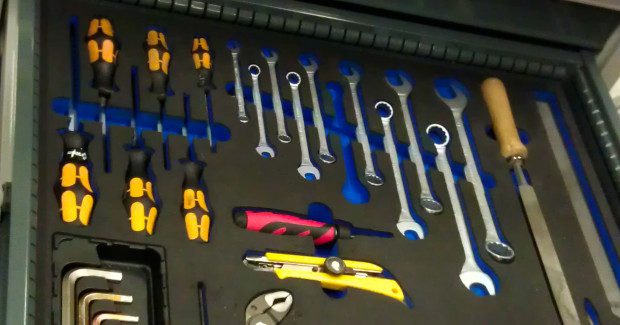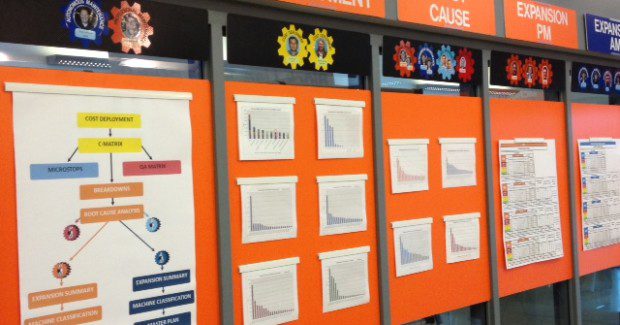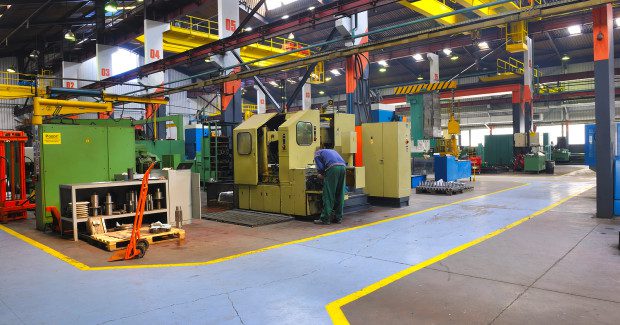The Making of a Visual Workplace
One of the key components to 5S workplace organization and the war on waste – and one of the most misunderstood opportunities for huge improvement – is the use of visual devices that clearly and precisely explain how to perform error-free work safely, smoothly, reliably, and on time.
Posted: November 13, 2015
The entire world of work now strives to make work safer, simpler, more logical, reliable and linked, and less costly. Central to this is the visual workplace – not a brigade of buckets and brooms or posters and signs, but a compelling operational imperative, central to your shop’s war on waste and crucial to meeting daily performance goals, vastly reduced lead times and dramatically improved quality. Many shops still do not understand the tremendous power of workplace visuality. Instead, they treat it as an add-on to some other improvement effort, whether lean or six sigma. “We know what visual is . . . let’s put up some signs and put down some lines.” This is not just a mistake in thinking; it is the loss of a huge improvement opportunity.
TRANSLATING VITAL INFORMATION INTO VISUAL DEVICES
What precisely is a visual workplace? A self-ordering, self-explaining, self-regulating, and self-improving work environment where what is supposed to happen does happen, on time, every time, day or night – because of visual solutions. This is worth a closer look. First, the “self-” components describe how a visual workplace functions differently in modes that are safer, better, faster and smoother:
- Is in order, order you can see, and is able to harness that order for a business advantage.
- Explains itself to anyone and everyone in it by sharing vital information about what to do/what not to do, how and when to do it, and how to respond if something (including yourself) goes wrong.
- Is transparent because it explains itself, a visual work environment can regulate itself through high impact/low-cost visual devices.
- Acquires the ability, over time, to correct itself and become self-improving because visual devices are constantly providing feedback on our performance and the performance of the company itself.
Next, the “happen-time” components describe how a shop can, through visual devices, ensure the precise execution of both technical and procedural standards, where work is performed with precision, reliably and predictably translating perceived value (what the customer wants) into received value (what the customer buys). So what precisely is a visual device? An apparatus, mechanism, item, or thing that influences, directs, limits or controls behavior by making information vital to the task-at-hand, available at-a-glance, without speaking a word.
A GIGANTIC ADHERENCE MECHANISM
Visual devices translate the thousands of informational transactions that occur every day at work into visible meaning that doesn’t just impact performance, it creates performance. A visual workplace is made up of hundreds, even thousands, of such devices, created by the workforce that needs them. Added up, these devices create a language of excellence in the business, a language that speaks to everyone and anyone who wants to listen. The question every shop manager should ask: Is your workplace speaking the language of excellence to you?
THE PROBLEM: INFORMATION DEFICITS
As every shop knows, workplace information can change quickly and often: production schedules, customer requirements, engineering specifications, operational methods, tooling and fixtures, material procurement, work-in-process, and a thousand other details on which the daily life of the business depends. In any single day, literally thousands of informational transactions are required to keep work current, accurate, and timely.
But what happens when this vital information is hard to access, incomplete, inaccurate, or simply missing? People ask lots of questions and lots of the same questions, repeatedly. An information-scarce workplace is the opposite of a visual workplace. When key information is not instantly available, the shop pays for that in long lead times, late deliveries, poor quality, mistakes, accidents, low operator and managerial morale, and runaway costs. When workplace visuality is not firmly in place, these unhappy occurrences are chronic and unrelieved. They happen “all the time,” which means daily, weekly, monthly, yearly. Struggle becomes a way of life.
In the pre-visual workplace, everything and everyone are forced to exist within a narrow definition of their capability. The physical work environment is devoid of definition or conveyed context. There is no common purpose. It is devoid of meaning. Attempts to improve the process of work invariably fail because even the smallest gains disappear overnight. A pre-visual workplace has no means to sustain them, however hard-won. This is the unhappy state of affairs that results from chronic deficits of information: unanswered questions.
Far too many offices and production floors are flooded with questions that are asked, but many more experience a worse condition: questions that are unasked. This is “worse” because all too often when a question is not asked, people make stuff up. They simply make up an answer. Sometimes that works to the benefit of the shop, but all too frequently it works against it. People make stuff up and accidents happen, material is lost, defects are produced, delivery times are missed, and customers flee.
Working in an environment without visual information sharing is like trying to reach a destination by driving a hundred miles without a map, on a road with no road signs, no traffic signals, and no lines down the center of the road. You can probably make it but you are likely to pay a terrible price. Verbal questions are so commonplace in most companies that some people, including managers and supervisors, sometimes think that their main job is to provide the answers day in and day out, all the time. Calculating the level of information deficits (missing answers) in your shop is the quickest way to diagnose the extent to which a visual work environment is both absent and needed. You can do this by keeping track of the questions you are asked in the front of a memo pad – and tracking the questions you ask in the back.
Another way is to implement The First-Question-Is-Free Rule. Here’s how that works:
- When someone approaches you with a question, answer it politely and clearly. But as that person walks away, make a mental note: That’s one.
- Then wait until you are asked that same question again, either by the same person or someone else. Again answer the question politely and clearly, and as that person walks away, make the mental note: That’s two!
- The first question is free. The second time you hear that same question from the same person or anybody else, it’s time for you to create a visual device so that you never ever have to answer that question again and no one ever has to ask it.
Start taking concrete steps in turning your work shop into a visual workplace. Notice the information deficits around you. Notice the questions, and the answers that are missing. Then start answering them through visual devices. Create a workplace that speaks.
VISUAL DEVICES: LETTING THE WORKPLACE SPEAK
In a visual workplace, information is converted into simple, commonly-understood visual devices, installed in the process of work itself, as close to the point of use as possible. The result is the transformation of a formerly mute work environment into one that speaks clearly and precisely about how to perform error-free work safely, smoothly, reliably, and on-time. What happens when the workplace speaks? What happens when formerly voiceless work stations, equipment, tools, machines, and material can communicate freely and precisely with us? What happens when we can know vital information – the details of work – at a glance, without speaking a word, without asking (or answering) a single question?
When a company becomes a fully-functioning visual workplace, each employee has instant on-demand access to information that is vital to their own work and the business is infused with intelligence that you can literally see; intelligence that illuminates and drives the corporate intent and results in tangible benefits your shop can take to the bank. In a visual enterprise, every section of the floor, every bench, work surface, hand tool, part, machine, rack, cabinet, and bin is equipped to make a contribution to the collective purpose that is beyond its mere existence, because now that item can visually communicate vital information to anyone and everyone who needs it as they need it. There are no exceptions.
In a visual workplace, floors do not exist simply to walk on or hold things up. They function: showing us where it is safe to walk, where materials are, and where we are supposed to work. Benches are not merely surfaces on which to place parts and tools. Through the visual, benches tell us the exact location of the “things” of work, or show us that they are missing. A simple address can even save lives. Departments need not merely be a collection of furniture, things, and people. When we give them a voice through workplace visuality, they become productive allies that manage themselves and the enterprise as well. Tools are no longer restricted to merely helping us convert material. They can tell us how to use them properly, when they need to be calibrated, and when they are unsafe.
In a visual workplace, tools become vocal partners in the production process. And when we create equipment that speaks, machines can assist in their own quick changeovers. In this full-functioning environment, the things of the physical workplace and the workplace itself contribute to the making of profit in ways that go far beyond their mere presence. Through visuality, they become active, sustaining partners in the process of work and day-to-day improvement.
Imagine that any employee – whether a newcomer, veteran, or temp – could safely, effectively, and efficiently run a new process in your shop with merely a simple orientation because that process is visually capable, with vital performance information available instantly at point of use. What would that mean for your bottom line? Go further. What if your entire business operation, from sales and customer service through design, production, and shipping, was visually capable of responding to changes in minutes instead of days? Would that improve your competitive advantage?
Can you see the connection between the solutions we’ve discussed here and the applications that are right for your shop? Do you begin to see the great power of information that is embedded into the process of work, visually available to everyone and anyone who needs it, as close to the point of use as possible? If you do, you are already on your way to workplace visuality.





